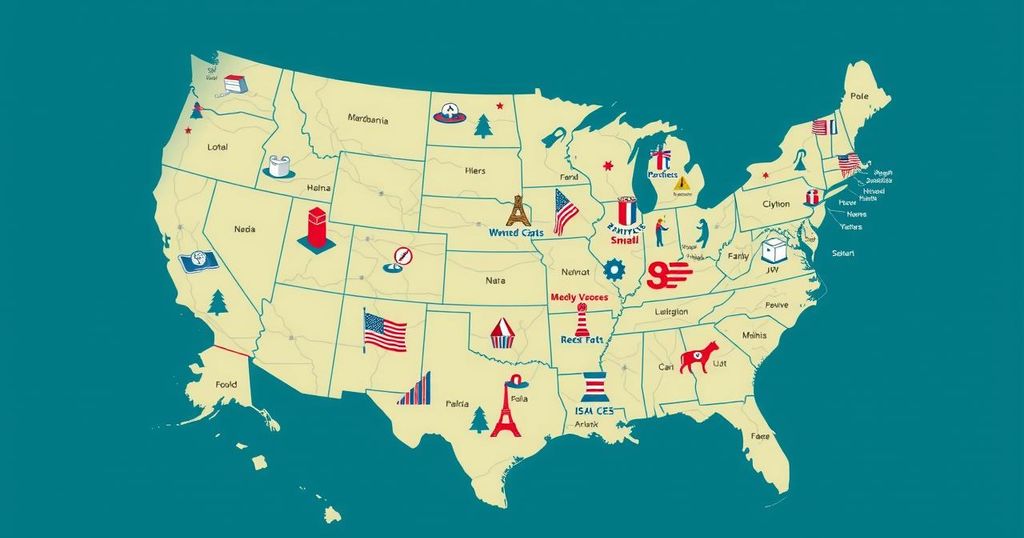Al Jazeera analyzes the United States ahead of the November 5, 2024 elections using 20 maps that depict the economy, demographics, geography, and critical societal issues. Key findings reveal disparities in unemployment rates, minimum wage laws, income taxes, homelessness, and crime rates among states, while also highlighting the influence of these factors on voter sentiment as crucial electoral decisions approach.
Ahead of the November 5, 2024 elections, Al Jazeera provides a comprehensive analysis of the United States through 20 illustrative maps that highlight various indicators, including the economy, demographics, geography, and history of the country comprising approximately 335 million citizens. In terms of economic strength, the United States boasts the largest Gross Domestic Product (GDP), recorded at $29 trillion, with California leading the states at $4.8 trillion, followed by Texas and New York with $2.9 trillion and $2.3 trillion, respectively. The unemployment rate, as reported by the Bureau of Labor Statistics, stands at 4.1 percent, translating to roughly seven million individuals actively seeking employment, while states like the District of Columbia (5.7 percent), Nevada (5.5 percent), and California (5.3 percent) experience the highest unemployment rates. Minimum wage policies are a significant focus for Democrats, with Vice President Kamala Harris advocating for a doubling of the federal minimum wage of $7.25 per hour, while certain states like California ($16), Washington ($16.28), and D.C. ($17) have set higher minimum wage levels. Conversely, Georgia and Wyoming maintain a minimum wage lower than the federal standard, at $5.15 per hour. The income tax landscape reveals California, Hawaii, and New York as states with the steepest income tax rates for higher earners, contrasting with the absence of state income tax in states like Florida, Texas, and Nevada. The issue of homelessness has also become increasingly pressing, with the 2023 Annual Homeless Assessment Report indicating a rate of 20 people experiencing homelessness per every 10,000 individuals in the nation, with the District of Columbia, New York, and Vermont exhibiting the highest rates. The wealth distribution in the United States is highlighted by notable figures such as Elon Musk, Jeff Bezos, and Mark Zuckerberg, who are among the richest individuals residing in Texas, Florida, and California, respectively. The geographical scope of the US makes it the third-largest country, with Alaska holding the title of the largest state, comparable in size to Libya. Population statistics show California as the most populated state (39 million) and Wyoming as the least (fewer than 600,000 residents). While New Jersey is the most densely populated state (487 people per square kilometer), states like Alaska and Wyoming remain among the least densely populated. The demographic profile reveals immigration as a pivotal factor, especially with California hosting the highest percentage of foreign-born residents (27 percent). According to the 2020 Census, demographic changes reflect a shift in racial and ethnic representation. White non-Hispanic individuals account for 57.8 percent of the population, followed by Hispanic or Latino at 18.7 percent and Black or African American at 12.1 percent. Highlights include Utah possessing the largest youth voting bloc and states like Arkansas and Mississippi exhibiting the highest maternal mortality rates. Lastly, issues surrounding crime rates, mass shootings, the death penalty, and abortion restrictions are critical in the political discourse leading to the election, showcasing a complex socio-political landscape shaped by varying state policies and public sentiment. These maps serve as a vital tool for voters to understand the multifaceted dimensions of American society as they prepare to engage in the electoral process.
As the upcoming 2024 US Presidential Election approaches, understanding the current socio-economic landscape of the United States becomes crucial for voters. The article provides a detailed visual account through maps that illustrate various aspects affecting voter sentiment and policy discussions. Key indicators examined include economic performance, unemployment rates, income tax variations, minimum wage discrepancies, and demographic compositions across states, highlighting the disparities and challenges present in American society that will likely influence voter decisions at the polls. This analysis is not merely statistical; it contextualizes the challenges faced by citizens, such as homelessness, crime rates, maternal mortality, and immigration, against the backdrop of political campaigning and voter engagement strategies, particularly those of candidates like Kamala Harris and Donald Trump. By leveraging this cartographic presentation, readers gain insight into the complex interplay between geography, demographics, and political priorities.
In conclusion, the analysis provided through the 20 maps sheds light on critical dimensions of the United States as it approaches the significant electoral event of November 2024. The intersections of economic performance, minimum wage debates, immigration, crime rates, and demographic shifts reveal a nation grappling with vital issues that inform voter priorities. As Americans prepare to cast their votes, an understanding of these multifaceted aspects may serve to enhance informed decision-making within the electorate.
Original Source: www.aljazeera.com






